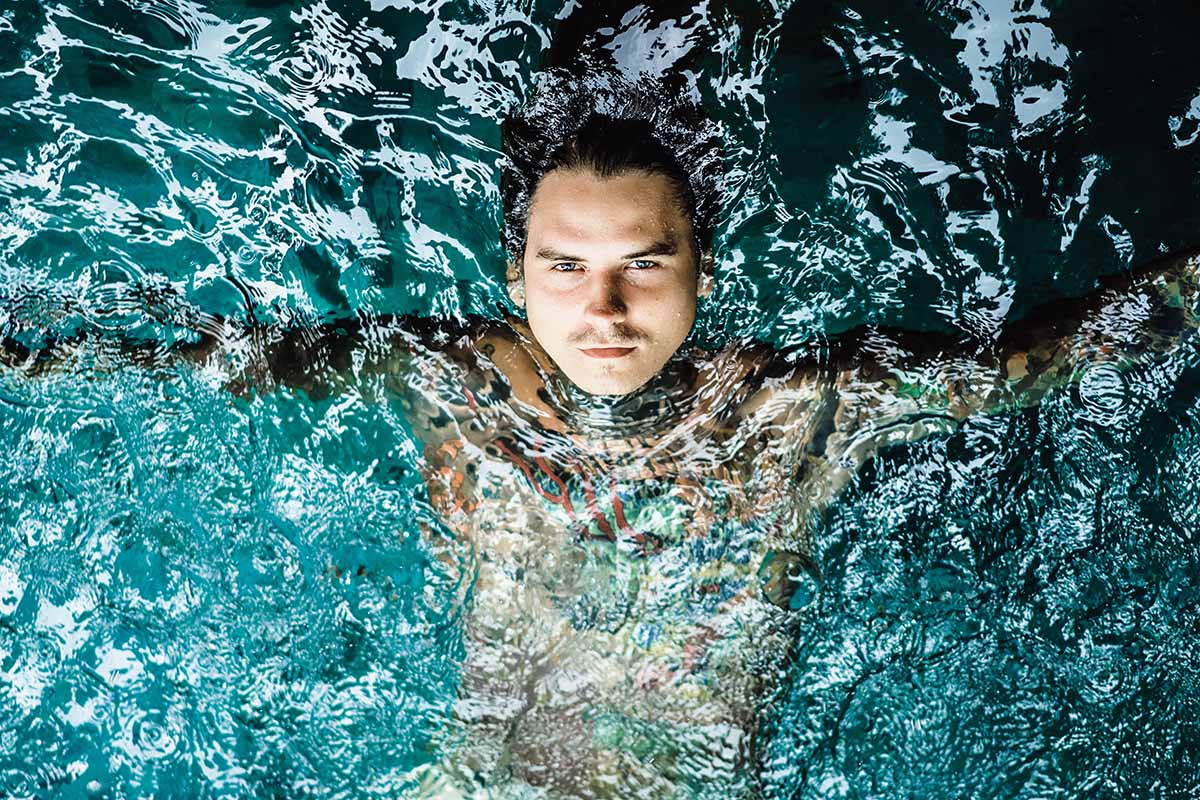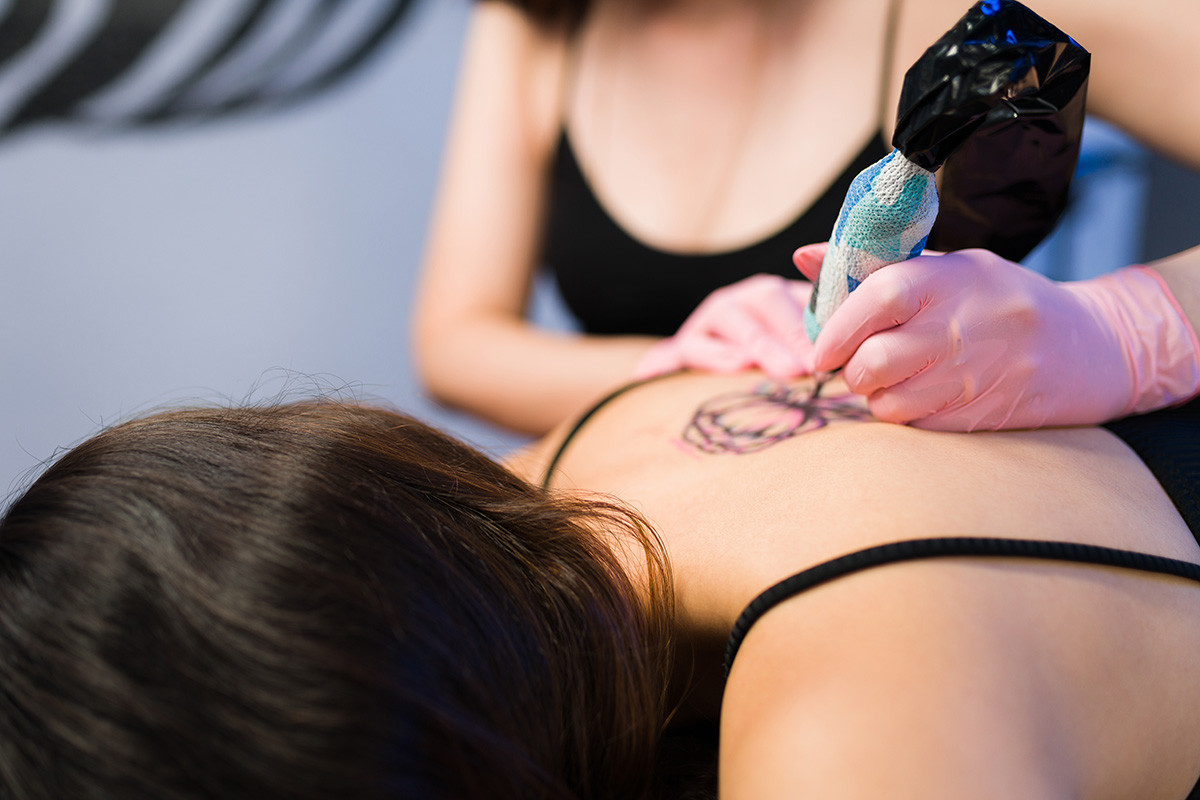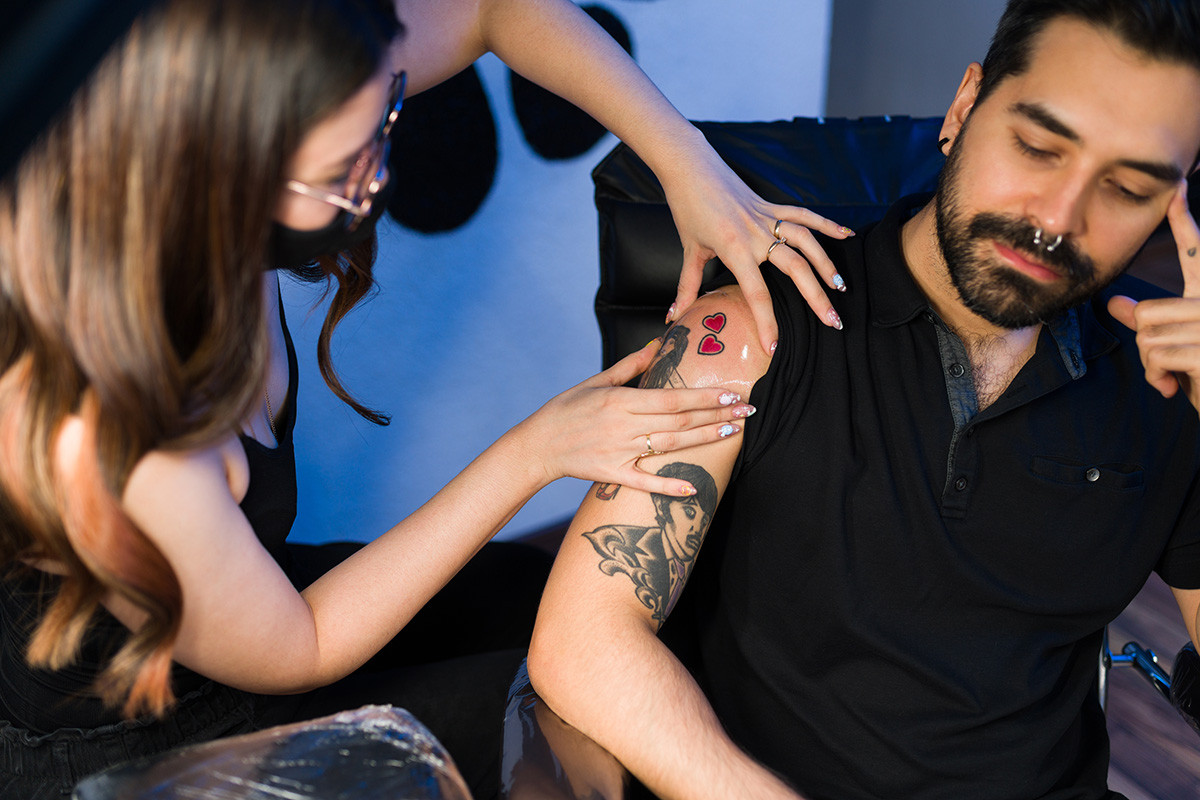Are you wondering, “Can You Get In Water After Tattoo?” The answer is generally no, especially not immediately. At tattooat.com, we understand your excitement about showing off your new body art, but proper tattoo aftercare is essential. We are here to guide you through the healing process, explaining why water exposure poses risks and offering tips to protect your ink.
The healing period is crucial for preventing infections and ensuring your tattoo remains vibrant. Let’s explore the stages of tattoo healing, the potential dangers of water exposure, and how to enjoy water activities safely while preserving your stunning tattoo.
1. When Can You Dive In? Understanding Tattoo Healing
 A person getting a new tattoo and the healing process
A person getting a new tattoo and the healing process
Getting a fresh tattoo is super exciting. It’s like adding a personal masterpiece to your body. But, it’s important to know that proper aftercare is crucial to ensure the beauty and health of your new body art. A new tattoo is essentially an open wound, and dipping it in water too soon can lead to infections, irritation, and even damage to the design. Tattoo artists generally recommend waiting at least 2 to 4 weeks before fully submerging your new tattoo in water like swimming pools, hot tubs, or the ocean.
Healing times can vary. Factors like the tattoo’s size and location, your skin type, and how well you follow aftercare instructions all play a role. Understanding the stages of tattoo healing and what affects the healing time can help ensure the best outcome for your new ink.
1.1. The Stages of Tattoo Healing
The tattoo healing process is a journey with distinct stages. Initially, you might experience swelling, pain, and some oozing in the first few days. This is normal as your body reacts to the new tattoo. Following this phase, itching and peeling will occur as the skin regenerates. Consistent aftercare during this time is crucial. According to Inked Magazine, full healing can take anywhere from 2 to 4 weeks, although some individuals may require up to 6 months for complete healing. Avoiding swimming during this period is essential to prevent irritation and infection.
It can be tempting to jump into the pool or ocean, but open water carries the highest risk of bacterial infection. Infections can really slow down healing and even damage your tattoo. Patience is key, and waiting until your tattoo is completely healed before swimming is always the best choice.
1.2. Factors Affecting Healing Time
Several things can affect how long your tattoo takes to heal. Understanding these factors can help you take better care of your new ink:
- Size of the Tattoo: Larger tattoos take longer to heal simply because there’s more area for the body to repair.
- Location of the Tattoo: Areas with more friction, like joints or places where clothing rubs, can take longer to heal.
- Aftercare: Following your tattoo artist’s aftercare instructions is vital. Cleaning, moisturizing, and protecting the tattoo are key.
- Skin Type: Everyone’s skin heals differently. Some skin types may heal faster than others. If you have sensitive skin, you might need extra care. According to a study by Portland State University’s Art Department in July 2023, individuals with sensitive skin experienced longer healing times by an average of 15%.
Monitoring your tattoo closely and addressing any concerns with your artist is crucial. They can offer personalized advice and help ensure your tattoo heals properly.
2. Unveiling Risks of Swimming with a New Tattoo
Swimming with a fresh tattoo is not a good idea because it can create many potential problems. Water can dry out your skin, which causes increased itching, flaking, and scabbing – not a good situation. These problems can also lead to fading, patchiness, and blurred lines in your new tattoo, which is definitely not the effect you want when you get new ink.
Besides the physical discomfort and potential damage to your tattoo, swimming with a new tattoo can also raise the risk of bacterial infections. Pools, lakes, and oceans have a lot of bacteria, and your healing tattoo is an open wound that is at risk to these invaders. For the safety of your tattoo and to ensure a smooth healing process, it’s best to avoid swimming until your tattoo has fully healed.
2.1. Bacterial Infections and Open Wounds
Tattoos are considered open wounds because they involve breaking the skin and putting a foreign substance (ink) into the body. Submerging your healing tattoo in water can expose it to harmful bacteria in pools, lakes, and oceans. According to the Journal of American Academy of Dermatology in July 2024, this exposure can lead to irritation, infection, and other complications that can harm your tattoo and slow down the healing process.
Keeping your new tattoo clean and protected from water is important to reduce the risk of bacterial infections. Waterproof dressings and bandages can protect your tattoo from bacteria and other contaminants while swimming. When it comes to your tattoo’s health, it’s always better to be safe than sorry.
2.2. Chlorine and Salt Water Effects
Chlorine and salt water can harm your new tattoo. These elements can cause:
- Irritation
- Fading
- Discoloration
- Leaching of the ink from your tattoo
Even in a chlorinated pool, chlorine doesn’t kill all bacteria and can still pose a risk to your healing tattoo.
Additionally, chlorine and salt water can dry out the skin, making any irritation worse and prolonging the healing process. To ensure your tattoo heals well and keeps its vibrant appearance, it’s best to avoid swimming until it has completely healed.
3. Protecting Your New Tattoo While Swimming: Is It Possible?
 A person protecting their new tattoo while swimming with waterproof dressings and bandages
A person protecting their new tattoo while swimming with waterproof dressings and bandages
If you absolutely must swim before your tattoo is fully healed, you can take some precautions to protect your tattoo. Using waterproof dressings and bandages can shield your tattoo from water and bacteria. However, the British Association of Dermatologists advises that waterproof coverings should only be considered as a last resort, as they can create a humid environment that promotes bacterial growth. Make sure to remove the dressing right after swimming and thoroughly clean your tattoo to minimize the risk of infection.
Swimming with a new tattoo is not recommended. Taking these precautions doesn’t guarantee that your tattoo will be safe from infection or damage. Waiting until your tattoo is fully healed before submerging it in water is always best, but if you must swim, take the necessary steps to protect your art.
3.1. Waterproof Dressings and Bandages
If you need to swim with a new tattoo, waterproof dressings and bandages can be a lifesaver. These coverings are designed to create a barrier between your tattoo and the water, helping to keep your new ink safe from bacteria and contaminants.
Some popular waterproof dressings include:
| Dressing | Description |
|---|---|
| Saniderm Tattoo Aftercare Bandage | Popular for its breathability and strong adhesive. |
| Recovery Derm Shield | Provides a protective barrier while remaining flexible. |
| Nexcare Waterproof Bandages | Widely available and effective for small to medium-sized tattoos. |
| Nuanchu Waterproof Bandage | Offers reliable protection and is easy to apply. |
Apply the dressing before swimming and remove it immediately afterward, changing it regularly to ensure your tattoo remains protected. Always follow the manufacturer’s instructions for application and removal to avoid skin irritation.
3.2. Post-Swim Care: Essential Steps
Taking care of your tattoo after swimming is key to reducing the risk of infection and damage. Here’s what you should do:
- Cleanse Gently: Wash the tattoo gently with warm water and a mild, fragrance-free soap. Avoid harsh scrubbing.
- Pat Dry: Pat the area dry with a clean, soft towel. Do not rub, as this can irritate the skin.
- Moisturize: Apply a thin layer of a fragrance-free moisturizer to keep the skin hydrated and promote healing.
Following these steps can help maintain the health and appearance of your tattoo. Always prioritize cleanliness and hydration to support the healing process.
4. Signs Your Tattoo Is Ready for Swimming: What to Look For
Once your tattoo has fully healed, you can enjoy swimming without worrying about damage or infection. But how do you know when your tattoo is ready for a swim? Key signs include the absence of redness, itching, scabbing, or flaking, and a smooth, even appearance without peeling.
If unsure, consult your tattoo artist or a healthcare professional before swimming. They can assess your tattoo’s healing progress and provide guidance on when it’s safe to dive in.
4.1. Visual Indicators of a Healed Tattoo
Visual indicators can help you determine if your tattoo is ready for swimming. Look for these signs:
- No Redness or Irritation: The skin around the tattoo should not be red or inflamed.
- No Scabbing or Flaking: All scabs and flakes should have naturally fallen off.
- Smooth Texture: The tattoo should feel smooth to the touch, with no raised areas.
- Even Appearance: The colors should be consistent and vibrant, without any fading or discoloration.
Monitoring your tattoo closely throughout the healing process is essential. If you notice any unusual symptoms, contact your tattoo artist or a healthcare professional for advice.
4.2. The Importance of Consulting Your Tattoo Artist
Your tattoo artist is an invaluable resource for determining when your tattoo is ready for swimming. They have experience with the healing process and can assess your tattoo’s progress, providing expert guidance on when it’s safe to expose your ink to water.
If unsure, visit the studio where you got your tattoo and have a professional check it. It’s always better to be cautious and ensure your tattoo is fully healed before swimming. Tattoo artists at studios like Seven Doors Tattoo in Portland, OR, offer aftercare check-ups.
5. Alternative Water Activities During Tattoo Healing Period
 A person enjoying alternative water activities during the tattoo healing period
A person enjoying alternative water activities during the tattoo healing period
If you want to get in the water while your tattoo is healing but don’t want to risk damaging your new ink, there are alternative water activities. Instead of swimming, take gentle showers, avoiding direct water jets. Cleansing with boiled tap water is another option to reduce infection risk.
Keeping your new tattoo clean and protected from water during healing is essential. By choosing alternative water activities, you can enjoy the water while ensuring your tattoo heals and looks its best.
6. Hot Tubs, Saunas, and Other Water Hazards: What to Avoid
Hot tubs and saunas can pose risks to your new tattoo. The warm, moist environment increases the risk of bacterial infections and hinders tattoo healing. Waiting at least 3-4 weeks after getting a tattoo before entering a hot tub or sauna is recommended.
Avoiding hot tubs, saunas, and other water-based environments during healing protects your new tattoo and ensures it heals. Once healed, you can enjoy water activities without worry.
7. Finding Inspiration and the Right Artist at tattooat.com
Choosing the right tattoo design and artist is a crucial step. At tattooat.com, we offer a wide array of tattoo designs across various themes and styles. Whether you are seeking inspiration or have a specific design in mind, our platform can help you discover the perfect tattoo. Additionally, finding a skilled and reputable tattoo artist is essential for ensuring a safe and satisfactory experience. tattooat.com provides a curated list of talented artists and studios across the United States, including those in Portland.
7.1 Connecting with Local Artists
Finding the right artist is key, and tattooat.com makes it easy to connect with talented professionals. Our directory allows you to search for artists based on location, style, and specialization. Whether you’re looking for a traditional artist, a realism expert, or someone specializing in watercolor tattoos, you can find them on our platform. Many artists in Portland showcase their work and expertise on tattooat.com, making it simple to find the perfect match for your vision.
7.2 Exploring Tattoo Designs
Inspiration is just a click away with tattooat.com’s extensive collection of tattoo designs. Browse through thousands of images categorized by theme, style, and body placement. Whether you’re interested in minimalist designs, intricate sleeves, or vibrant color tattoos, you’ll find plenty of ideas to spark your creativity. Our platform also features articles and guides on popular tattoo styles, helping you make an informed decision.
8. Understanding Tattoo Styles
Exploring various tattoo styles is important in the design process. Different styles can convey different messages and fit different personalities. Traditional tattoos, known for their bold lines and classic imagery, are a timeless choice. Realism tattoos capture detailed images with stunning accuracy, while watercolor tattoos offer a soft and artistic look.
8.1 Traditional Tattoos
Traditional tattoos, also known as old-school tattoos, are recognized for their bold lines, bright colors, and iconic imagery. These designs often feature nautical themes, roses, eagles, and other classic motifs. Traditional tattoos are timeless and durable, making them a popular choice for those seeking a long-lasting design.
8.2 Realism Tattoos
Realism tattoos aim to replicate images with stunning accuracy. These tattoos require skilled artists who can capture intricate details and shading to create lifelike portraits, landscapes, and other subjects. Realism tattoos are perfect for those seeking to immortalize a loved one, a favorite scene, or a meaningful object.
8.3 Watercolor Tattoos
Watercolor tattoos mimic the delicate and flowing appearance of watercolor paintings. These tattoos use soft colors and blurred lines to create an artistic and ethereal effect. Watercolor tattoos are ideal for those seeking a unique and visually striking design.
9. The Significance of Tattoo Placement
Choosing the right placement for your tattoo is just as important as selecting the design and style. The location on your body can impact the tattoo’s visibility, healing time, and overall aesthetic. Some popular placements include the arm, back, chest, and leg. Each area has its unique considerations, such as skin sensitivity and potential for fading.
9.1 Arm Tattoos
Arm tattoos are a popular choice due to their visibility and versatility. The arm offers ample space for various designs, from small symbols to full sleeves. The upper arm is less sensitive than the inner arm, making it a good option for first-timers.
9.2 Back Tattoos
Back tattoos provide a large canvas for intricate and detailed designs. The back is relatively flat and has fewer nerve endings, making it a less painful area for tattooing. Back tattoos can be easily concealed or showcased, depending on your preference.
9.3 Chest Tattoos
Chest tattoos are a bold and expressive choice. The chest offers a broad area for designs that can be both symmetrical and asymmetrical. However, the chest can be more sensitive due to the presence of the sternum and ribs.
10. Overcoming Concerns and Misconceptions
Many people have concerns about getting a tattoo, such as pain, safety, and long-term effects. However, with proper preparation and research, these concerns can be easily addressed. Choosing a reputable studio, following aftercare instructions, and understanding the healing process can ensure a positive experience.
10.1 Addressing Pain Concerns
Pain is a common concern for those considering a tattoo. However, pain tolerance varies from person to person. Certain areas, such as the ribs and feet, tend to be more sensitive, while others, like the outer arm and thigh, are less so. Numbing creams can also be used to minimize discomfort.
10.2 Ensuring Safety and Hygiene
Safety and hygiene are paramount when getting a tattoo. Always choose a licensed and reputable studio that follows strict sterilization procedures. Ensure that the artist uses new, disposable needles and wears gloves. Don’t hesitate to ask about their safety protocols.
10.3 Understanding Long-Term Effects
Tattoos are permanent, so it’s essential to consider the long-term effects before getting inked. Over time, tattoos may fade or blur due to sun exposure and skin aging. However, proper aftercare and occasional touch-ups can help maintain their vibrancy.
11. Keeping Up with Tattoo Trends and Events
Staying updated with the latest tattoo trends and events can provide inspiration and connect you with the tattoo community. Tattoo conventions, artist spotlights, and social media platforms offer a glimpse into the evolving world of tattooing.
11.1 Tattoo Conventions and Events
Tattoo conventions are gatherings of artists, enthusiasts, and vendors. These events offer a chance to meet artists, see live demonstrations, and get inked on the spot. Some popular tattoo conventions in the United States include the Portland Tattoo Expo and the Hell City Tattoo Festival.
11.2 Artist Spotlights and Social Media
Social media platforms like Instagram and Pinterest are great resources for discovering new artists and tattoo styles. Many artists showcase their work online, allowing you to browse through their portfolios and find inspiration. Following hashtags like #tattooart, #tattooartist, and #tattoodesign can help you stay updated with the latest trends.
12. Summary: Protecting Your Ink
Understanding the tattoo healing process and the risks of swimming too soon is essential for protecting your new art. By following aftercare guidelines, using waterproof dressings when necessary, and waiting until your tattoo is fully healed before swimming, you can ensure a smooth healing process and maintain your tattoo’s appearance.
Prioritizing the health and safety of your new tattoo is essential, whether you’re a seasoned ink enthusiast or a first-timer. Before diving in, ensure your tattoo is ready – patience pays off when preserving your ink’s beauty.
Visit tattooat.com to explore designs, find artists, and learn more about tattoo aftercare. Dive into the world of tattoos with us!
13. Frequently Asked Questions
13.1 What happens if you swim while your tattoo is healing?
Swimming with a new tattoo is risky. It exposes the wound to bacteria in the water, causing infections from mild to severe. It can also irritate the skin, leading to itching, oozing blisters, and hives.
13.2 Can I swim 7 days after a tattoo?
Waiting for your tattoo to heal, typically two to four weeks, before swimming is advised. Swimming before then can risk infection from bacteria entering an open wound.
13.3 How long after a tattoo can you swim in chlorine?
Wait at least two to four weeks after getting a tattoo before swimming in chlorinated water to avoid infection.
13.4 Can I use waterproof dressings to protect my tattoo while swimming?
Waterproof dressings can protect your tattoo while swimming if fully healed. Ensure it’s healed before using them.
13.5 What are the risks of swimming with a fresh tattoo?
Swimming with a fresh tattoo risks bacterial infections, skin irritation, and design damage, so avoid it for the first few weeks. Take precautions to ensure your tattoo heals well and looks its best by waiting.
At tattooat.com, we are here to guide you through every step of your tattoo journey, from inspiration to aftercare. Visit our website today and discover the perfect design, connect with talented artists, and learn everything you need to know about keeping your ink looking its best. Contact us at 1825 SW Broadway, Portland, OR 97201, United States, or call +1 (503) 725-3000. Your dream tattoo awaits at tattooat.com.
